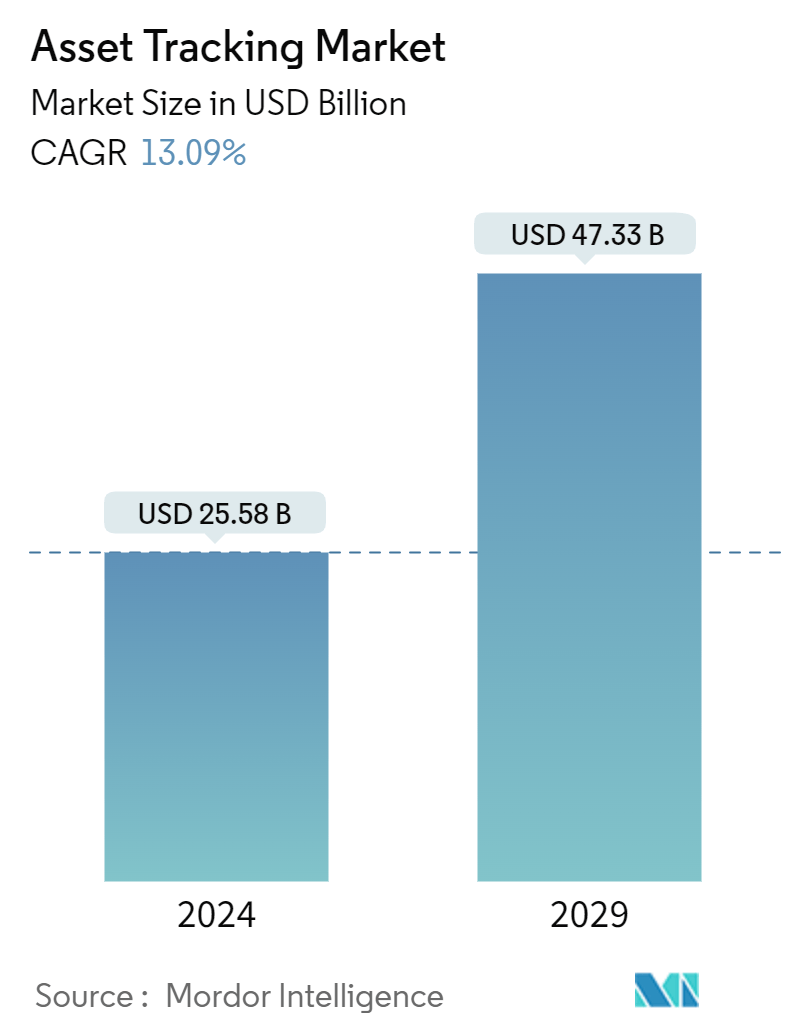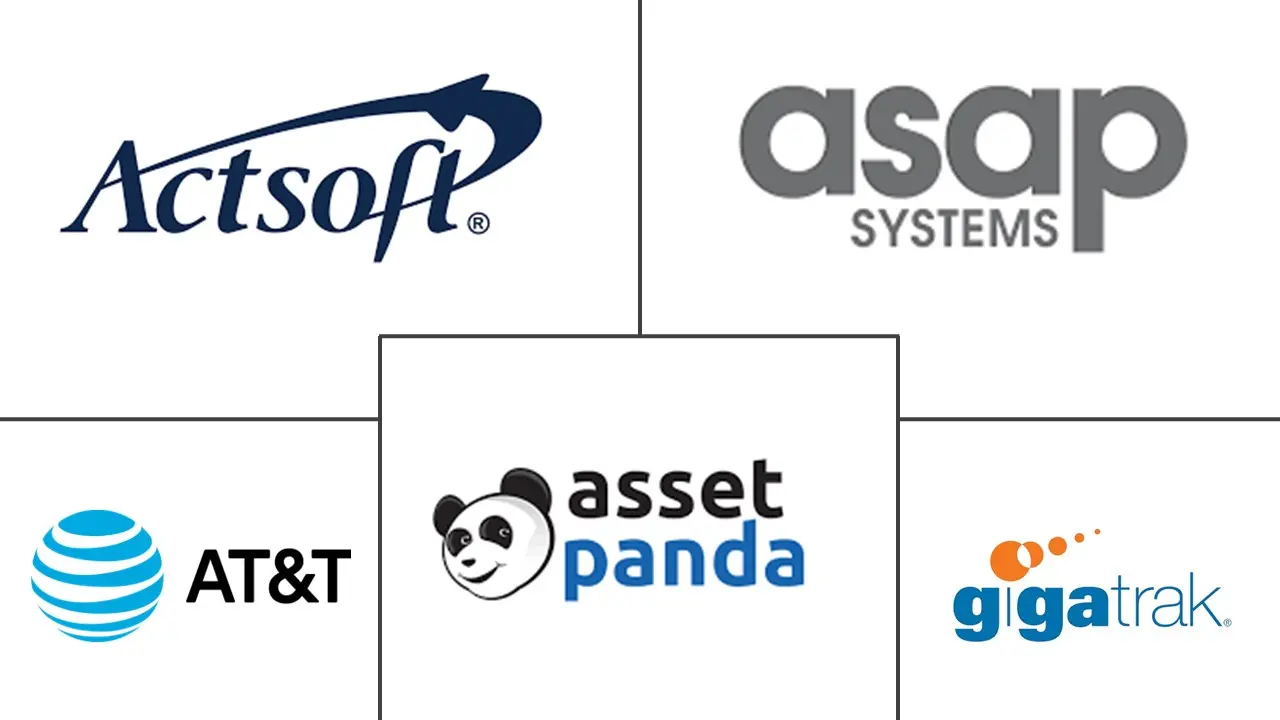Market Size of Asset Tracking Industry

| Study Period | 2019 - 2029 |
| Market Size (2024) | USD 25.58 Billion |
| Market Size (2029) | USD 47.33 Billion |
| CAGR (2024 - 2029) | 13.09 % |
| Fastest Growing Market | Asia Pacific |
| Largest Market | North America |
Major Players*Disclaimer: Major Players sorted in no particular order |
Asset Tracking Market Analysis
The Asset Tracking Market size is estimated at USD 25.58 billion in 2024, and is expected to reach USD 47.33 billion by 2029, growing at a CAGR of 13.09% during the forecast period (2024-2029).
- Asset management and tracking solutions are essential to achieve greater operational efficiencies in the current market scenario of rapid digitalization in manufacturing environments and office spaces. The asset tracking technology is deployed as hardware, including GPS, RFID, BLE, QR codes, and software for on-premises and cloud deployment.
- Recent advancements in IoT technology have enabled several end users, such as transportation and logistics, manufacturing, and food and beverage, to acquire economical and efficient asset-tracking hardware. For instance, in the healthcare segment, hospitals and other healthcare facilities must closely monitor the status of medical equipment due to its high cost to deter theft and ensure ongoing accessibility. The hospital tracking system enables real-time monitoring of supplies and equipment. It may give patients the care they need and significantly raise the standard of patient care.
- Industry 4.0 has aided early digitalization adopters in the industrial segment by saving time and resources on new projects. Asset tracking is the most beneficial and necessary aspect of this digitization. Mobile application tools and cloud-based asset tracking and monitoring significantly reduce the time and effort required to find and track assets. With continuous, real-time location and condition tracking and commodity evaluation, these systems improve efficiency at building sites. Corporate leaders prefer solution providers that offer cloud solutions as they require a robust asset monitoring solution with the proper IoT technology ability for large sites and operations.
- Post-pandemic, the market is witnessing considerable growth driven by the proliferation of IoT in various end-user industries, coupled with the growing demand to track and manage assets effectively. In addition, the market has witnessed substantial technological advancements in hardware and software in asset-tracking technology, positively impacting the growth of the asset-tracking market post-pandemic.
- Although the high initial costs are restraining the market growth, it is stimulated by the rising demand from third-party logistics players through value-added tracking services and the growing adoption of IoT devices for asset tracking. IoT-based asset tracking is gaining substantial traction as it leverages sensors and connected devices to remotely monitor and track an asset's geo position and movements. Also, IoT technology offers significant growth opportunities for monitoring assets, achieving efficiency gains, and implementing new business models for companies, notably in the industrial, transport, and logistics services.
Asset Tracking Industry Segmentation
Asset tracking refers to physical assets that are tracked by scanning barcode labels attached to them or using tags using GPS, BLE, barcode, QR, or RFID, which broadcast their location. The study tracks the revenues accrued for the asset tracking market. They are evaluated by analyzing the sale of IoT-based asset tracking hardware and software deployed on-premise and on-cloud for enabling real-time information on asset conditions, operations, locations, and maintenance requirements of fixed and mobile assets in different end-user applications like transportation and logistics, aviation, healthcare, manufacturing, food and beverages, and other end-user applications across different geographies. The study considers hardware leveraging technologies such as GPS, BLE, RFID, barcode, and QR.
Consumer asset tracking refers to tracking consumer physical assets using GNSS or other positioning technology and some wireless wide area networks such as cellular networks, satellite networks, LoRa, or Sigfox. The consumer asset market study does not include revenue accrued from consumer asset tracking solutions based solely on short-range technologies, such as Bluetooth and Wi-Fi. Also, the revenue accrued from the global asset tracking vendors and the COVID-19 impact on market projection had been considered.
The study is segmented by component (hardware and software), deployment (on-cloud and on-premise), end-user industry (transportation and logistics, aviation, healthcare, manufacturing, food and beverage, and other end-user industries), and geography (North America, Europe, Asia-Pacific, Latin America, and Middle East and Africa). The analysis is based on the market insights captured through secondary research and the primaries. The report tracks the key market parameters, the underlying growth influencers, and the major vendors operating in the industry, which may support the market estimations and growth rates during the forecast period. The report offers the market size in value terms in USD for all the abovementioned segments.
| By Component | |
| Hardware | |
| Software |
| By Deployment Type | |
| On-cloud | |
| On-premise |
| By End-user Industry | |
| Transportation and Logistics | |
| Aviation | |
| Healthcare | |
| Manufacturing | |
| Food and Beverages | |
| Other End-user Industries |
| By Geography*** | |
| North America | |
| Europe | |
| Asia | |
| Australia and New Zealand | |
| Latin America | |
| Middle East and Africa |
Asset Tracking Market Size Summary
The asset tracking market is poised for significant growth, driven by the increasing need for operational efficiency and the rapid digitalization across various sectors. As industries embrace Industry 4.0 and smart factory concepts, the adoption of advanced asset tracking technologies, such as IoT, GPS, RFID, and BLE, is becoming essential. These technologies enable real-time monitoring and management of assets, enhancing efficiency and security while optimizing resource utilization. The market is witnessing substantial advancements in both hardware and software solutions, with cloud-based deployments gaining traction. The healthcare sector, in particular, has seen a surge in demand for asset tracking solutions to monitor expensive medical equipment, ensuring availability and preventing theft. The COVID-19 pandemic further accelerated the adoption of these solutions, as businesses sought to ensure safety through contact tracing and asset monitoring.
North America is expected to hold a significant share of the asset tracking market, fueled by the high adoption of advanced technologies in the United States and Canada. The region's food and beverage sector, along with logistics and manufacturing industries, are key contributors to market growth. Strategic collaborations and product innovations, such as GE's asset management solutions and Verizon's mobile workforce management enhancements, are driving the adoption of asset tracking technologies. Despite challenges like high initial costs, the market is stimulated by the growing demand from third-party logistics providers and the increasing prevalence of IoT devices. The competitive landscape is marked by the presence of major vendors and new entrants, all investing in R&D to enhance their offerings and expand globally.
Asset Tracking Market Size - Table of Contents
-
1. MARKET INSIGHTS
-
1.1 Market Overview
-
1.2 Industry Attractiveness - Porter's Five Forces Analysis
-
1.2.1 Bargaining Power of Suppliers
-
1.2.2 Bargaining Power of Buyers
-
1.2.3 Threat of New Entrants
-
1.2.4 Threat of Substitutes
-
1.2.5 Intensity of Competitive Rivalry
-
-
1.3 Value Chain Analysis
-
1.4 Assessment of Impact of Macroeconomic Factors on the Market
-
-
2. MARKET SEGMENTATION
-
2.1 By Component
-
2.1.1 Hardware
-
2.1.2 Software
-
-
2.2 By Deployment Type
-
2.2.1 On-cloud
-
2.2.2 On-premise
-
-
2.3 By End-user Industry
-
2.3.1 Transportation and Logistics
-
2.3.2 Aviation
-
2.3.3 Healthcare
-
2.3.4 Manufacturing
-
2.3.5 Food and Beverages
-
2.3.6 Other End-user Industries
-
-
2.4 By Geography***
-
2.4.1 North America
-
2.4.2 Europe
-
2.4.3 Asia
-
2.4.4 Australia and New Zealand
-
2.4.5 Latin America
-
2.4.6 Middle East and Africa
-
-
Asset Tracking Market Size FAQs
How big is the Asset Tracking Market?
The Asset Tracking Market size is expected to reach USD 25.58 billion in 2024 and grow at a CAGR of 13.09% to reach USD 47.33 billion by 2029.
What is the current Asset Tracking Market size?
In 2024, the Asset Tracking Market size is expected to reach USD 25.58 billion.


